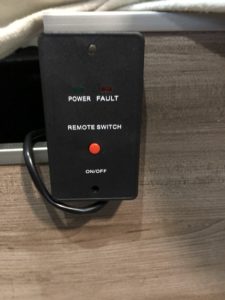One thing missing from our Jayco Silverline is a 240 volt inverter for off grid use. Sure we can use a generator and we have one but in a park this is usually not permitted. We have also had the situation where the power has failed in a caravan park (in South Australia of course).
We wanted to easily change over and have power to our existing 240v outlets. We want to run low power equipment such as TV (not 12 volt) and the microwave and a hair drier for short periods. This installation is using standard deep cycle batteries and not lithium batteries. If we bought a new van we would be using the latter.
The TV is 240 volt because the 12 volt ones are double the price and half the size. 12 volt hair driers are less powerful than their 240 volt counterparts but drawer up to 20 amps requiring an extra higher power 12 volt outlet that is hard to install where it is needed.
The solution:
We upgraded to a pair of deep cycle batteries ( the original battery was 90-95 AH) for 240 AH. The two batteries are identical and wired in parallel but for safety reasons with a circuit breaker between the batteries to avoid very high currents between the batteries if there is a mismatch between them ( and we did have one of the batteries fail causing this very problem). The brand was Kickass chosen for price and hopefully reliability based on user comments online. These are connected to the existing caravan 12v connections including the 240v battery charger and the solar panel. All of this is installed under the bed with room to spare for storage.
It is important to have large enough cables between the batteries and from the batteries to the inverter to handle at least 200 amps continuously and up to about 300 amps for a short period. We inadvertently installed one undersized wire and the insulation promptly melted!!


Next the inverter is a Kickass 3000W inverter ( a 2000W inverter would also work) (see the blue metal box in the top left hand image). It is connected to the battery by a high current isolating switch and a 250 amp fuse. The inverter has a fuse as well but it is in the metal box and consists of many 30 amp blade fuses for a total amperage of over 300 amps. I could not see myself having to replace those in a hurry so I elected to have a lower rated fuse externally. The inverter comes with a remote control on a long lead but I decided to install it on the side of the bed within easy reach
I plug in a 240 volt 10 amp to 15 amp circuit breaker (Bunnings). Into this I plug a 15 amp extension cord that goes through the floor to terminate in a power coupling cover ( right hand images) purchased form Bunnings. I had to put a 15 amp socket on this short cord once it had passed through the floor through a small whole sealed with silicone. It is legal to rewire an extension cord. Nothing else has been modified.


The coupling cover is screwed to the underneath of the floor. The rear end has the cord form the inverter and the forward end has a piece of extension cord in it when not in use to prevent ingress of dust ans water while travelling.
When not in use the 12 volt isolation switch is off so nothing runs.
When is it time to connect and run the inverter we do the following:
Plug in the little extension cord (15 amp) from the coupling under the floor to the external 240 volt inlet. Note that doing this prevents an external 240 volt supply being connected at the same time. Alternatively we can plug a power board into the inverter directly and run a few things from the power board.
Turn the fridge to gas (Must do this)
Turn of the 240 volt switch in the water heater and run it with gas. (Must do this)
Lift up the bed and clear anything away from the inverter and turn off the charger as there is no point in charging itself!
Turn on the 12 volt isolating switch
We now have 240 volt being supplied from the batteries with virtually no noise.
There aren’t many steps to turn it on!
Note that the load on the 240 volt outlet is limited to 10 amps (2.4KW) well inside the specification of the inverter) and it is a circuit breaker.
The input current is limited to 250 amp.. (250 x 12 = 3 KW) and would likely only blow if there was a fault.